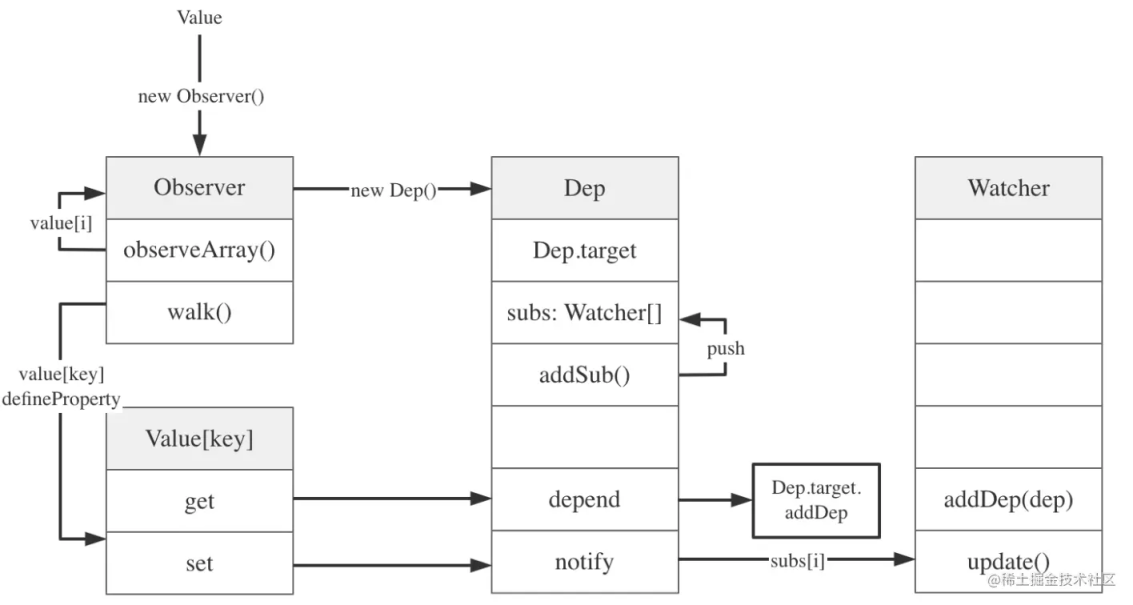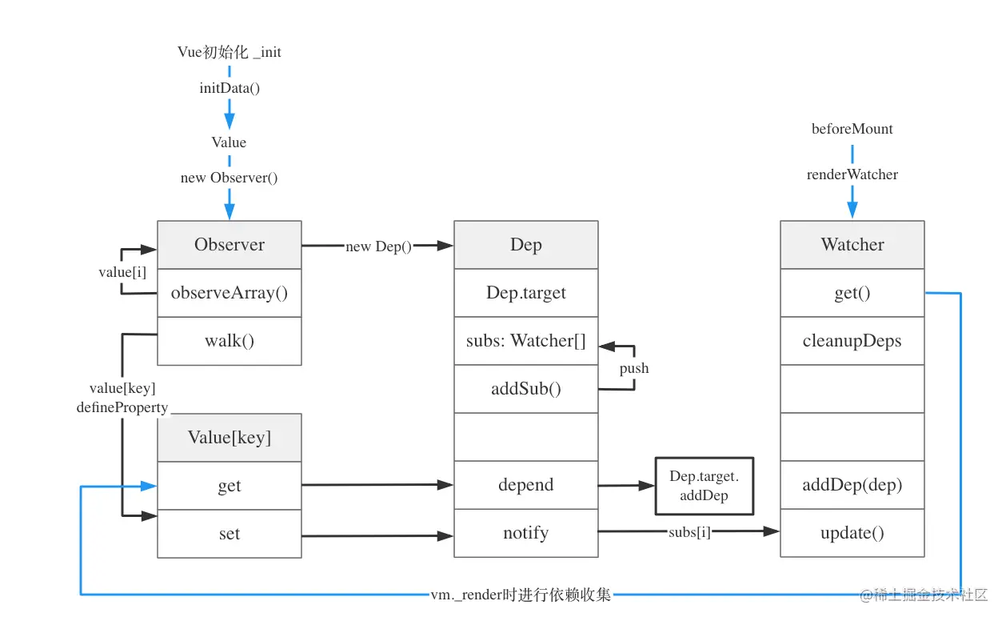背景
在 Vue 的初始化阶段,_init 方法执行的时候,会执行 initState(vm) ,它的定义在 src/core/instance/state.js 中。在初始化 data 和 props option 时我们注意 initProps 和 initData 方法中都调用了 observe 方法。通过 observe (value),就可以将数据变成响应式。
export function initState (vm: Component) { vm._watchers = [] const opts = vm.$options if (opts.props) initProps(vm, opts.props) if (opts.methods) initMethods(vm, opts.methods) if (opts.data) { initData(vm) } else { observe(vm._data = {}, true /* asRootData */) } if (opts.computed) initComputed(vm, opts.computed) if (opts.watch && opts.watch !== nativeWatch) { initWatch(vm, opts.watch) }}
复制代码
目标
源码解读
入口函数:observe
observe 方法定义在 src/core/observer/index.js 中。如果是一个非 VNode 的对象类型的数据,它会尝试给这个值去创建一个 observer 实例,如果创建成功,返回新的 observer。或者如果 ob 已经存在了,就会直接返回一个现有的 observer。
/** * 尝试给这个值去创建一个 observer 实例,如果创建成功,返回新的 observer * 或者如果值已经有了,返回一个现有的 observer * @param {*} value * @param {boolean} asRootData * @returns Observer | void */export function observe (value: any, asRootData: ?boolean): Observer | void { if (!isObject(value) || value instanceof VNode) { return } let ob: Observer | void // 如果 value 已经有 observer,就返回现有的 observer // 否则如果不是服务器渲染,value是数组或者对象,value 是可扩展的,value 不是 vue 实例,就创建一个新的 observer if (hasOwn(value, '__ob__') && value.__ob__ instanceof Observer) { ob = value.__ob__ } else if ( shouldObserve && !isServerRendering() && (Array.isArray(value) || isPlainObject(value)) && Object.isExtensible(value) && !value._isVue ) { ob = new Observer(value) } // 如果是根组件,vmCount 不为0 if (asRootData && ob) { ob.vmCount++ } return ob}
复制代码
通过 new Observer(value) 可以给 value 创建一个 observer 实例,那么 Observer 类的定义和作用是什么?在同一个文件下可以看到 class Observer 是如何定义的。
class Observer
Observer 方法定义在 src/core/observer/index.js 中。在它的构造函数中,首先实例化 Dep 对象(主要用来存放它的 watcher 列表),接着通过执行 def 函数把自身实例添加到数据对象 value 的 ob 属性上,所以存在 ob 属性意味着已经被观察过。最后判断 value 为数组的情况下,会数组项遍历,给数组的每一项创建一个 observe 实例;如果是对象,那么遍历所有的属性,通过 Object.defineProperty 修改 getter/setters。
/** * Observer 类和每个响应式对象关联。 * observer 会转化对象的属性值的 getter/setters 方法收集依赖和派发更新。 */export class Observer { value: any; dep: Dep; vmCount: number; // number of vms that have this object as root $data
constructor(value: any) { this.value = value this.dep = new Dep() // 存放 Observer 的 watcher 列表 this.vmCount = 0 def(value, '__ob__', this) // __ob__ 指向自身 observe 实例,存在 __ob__ 属性意味着已经被观察过 // 如果是数组 if (Array.isArray(value)) { // hasProto = '__proto__' in {} 判断对象是否存在 __proto__ 属性 if (hasProto) { // 如果有 __proto__,就将 value.__proto__ 指向 arrayMethods protoAugment(value, arrayMethods) } else { // 否则,就遍历 arrayMethods,将值复制到 value 上 copyAugment(value, arrayMethods, arrayKeys) } this.observeArray(value) // 数组项遍历,给数组的每一项创建一个 observe 实例 } else { this.walk(value) // 遍历所有的属性,修改 getter/setters } }
// 遍历所有的属性,修改 getter/setters,这个方法只有在 value 是object时调用 walk (obj: Object) { const keys = Object.keys(obj) for (let i = 0; i < keys.length; i++) { defineReactive(obj, keys[i]) } }
// 数组项遍历,给数组的每一项创建一个 observe 实例 observeArray (items: Array<any>) { for (let i = 0, l = items.length; i < l; i++) { observe(items[i]) } }}
复制代码
我们来看看对于数组和对象, Observe 分别做了什么处理。
Observe 如何处理数组
首先,对于 value 为数组而言,由于 proto 不是标准属性,有些浏览器不支持,比如 IE6-10,Opera10.1,所以需要根据对象是否存在 proto 属性区分在原型链上添加方法, protoAugment 和 copyAugment 都是在目标对象上添加属性值。
参考 vue 实战视频讲解:进入学习
/** * 将 target.__proto__ 指向 src * 拦截原型链__proto__,来增强目标对象或数组 * @param {*} target * @param {Object} src */function protoAugment (target, src: Object) { /* eslint-disable no-proto */ target.__proto__ = src /* eslint-enable no-proto */}
/** * 遍历 key 属性值列表,将 src 中的 key 属性值逐一定义到 target 的属性中 * 通过定义隐藏属性,来增强目标对象或数组 * @param {Object} target * @param {Object} src * @param {Array<string>} keys *//* istanbul ignore next */function copyAugment (target: Object, src: Object, keys: Array<string>) { for (let i = 0, l = keys.length; i < l; i++) { const key = keys[i] def(target, key, src[key]) // // 为 target 定义 key 和值 }}
复制代码
在原型链上添加的属性方法 arrayMethods 在 src/core/observer/array.js 可以找到他的定义。实际上 arrayMethods 就是 push pop shift unshift splice sort reverse 七个个方法。这么做的目的是因为要通过 proto 操作数据的原型链,覆盖数组默认的七个原型方法,以实现数组响应式。
Observe 如何处理对象
其次,对于对象而言,会去遍历对象的每个 key,调用 defineReactive(obj, keys[i]) 方法。它会为 obj[key] 创建一个依赖类 dep(会帮这个 key 定义一个 id 和 subs(watcher 订阅者列表) 方便依赖收集)然后再利用 Object.defineProperty 对对象的 get 和 set 方法做了处理。get 拦截对 obj[key] 的读取操作,set 拦截对 obj[key] 的写操作。
/** * 在对象上定义一个响应式的属性。 * @param {Object} obj * @param {string} key * @param {*} val * @param {*} customSetter * @param {*} shallow * @returns */export function defineReactive ( obj: Object, key: string, val: any, customSetter?: ?Function, shallow?: boolean) { const dep = new Dep() // 为 Object 的 key 创建一个依赖类,会帮这个key 定义一个 id 和 subs(watcher 订阅者列表)
const property = Object.getOwnPropertyDescriptor(obj, key) // 获取 obj[key] 的属性描述符,发现它是不可配置对象的话直接 return if (property && property.configurable === false) { return }
// cater for pre-defined getter/setters const getter = property && property.get const setter = property && property.set if ((!getter || setter) && arguments.length === 2) { val = obj[key] } // 对 obj[key] 进行观察,保证对象中的所有 key 都被观察 let childOb = !shallow && observe(val) Object.defineProperty(obj, key, { enumerable: true, configurable: true, get: function reactiveGetter () { const value = getter ? getter.call(obj) : val if (Dep.target) { dep.depend() if (childOb) { childOb.dep.depend() if (Array.isArray(value)) { dependArray(value) } } } return value }, set: function reactiveSetter (newVal) { // 旧的 obj[key] const value = getter ? getter.call(obj) : val // 如果新老值一样,则直接 return,不跟新更不触发响应式更新过程 /* eslint-disable no-self-compare */ if (newVal === value || (newVal !== newVal && value !== value)) { return } /* eslint-enable no-self-compare */ if (process.env.NODE_ENV !== 'production' && customSetter) { customSetter() } // setter 不存在说明该属性是一个只读属性,直接 return // #7981: for accessor properties without setter if (getter && !setter) return // 设置新值 if (setter) { setter.call(obj, newVal) } else { val = newVal } // 对新值进行观察,让新值也是响应式的 childOb = !shallow && observe(newVal) dep.notify() // 通知依赖的观察者更新 } })}
复制代码
可以看到,defineReactive(obj, keys[i]) 中对对象做了处理,不论嵌套的多深,都会 observe(value) 继续观察,在设置了新的值后,也会重新对新值进行观察,让新值也是响应式的。
上面的代码中,在 Observer 类构造函数执行时创建了一个 new Dep(),之后在定义对象的响应式属性时,也为 Object 的 key 创建一个依赖类 const dep = new Dep(),然后在 set 数据值会触发 dep.notify()。那么 Dep 的作用是什么呢?
class Dep
Dep 类的定义在 src/core/observer/dep.js 下。它的构造函数中定义了 id 和一个用于储存订阅这个 dep 的 watcher 的数组 subs[]。
/** * 一个 dep 对应一个 object.key,每次 key 更新时调用 dep.notify(), * dep 下的 subs 存放 Watcher 列表,可以调用 dep.notify() 触发 watcher.update() 使 Watcher 列表更新。 */export default class Dep { static target: ?Watcher; // Dep 类的静态属性,可以使用 Dep.target 访问,内容是 Watcher id: number; subs: Array<Watcher>; // Watcher 组成的订阅列表
constructor() { this.id = uid++ this.subs = [] // watcher 订阅者列表 }
// 向订阅者列表中添加一个订阅者 Watcher addSub (sub: Watcher) { this.subs.push(sub) }
// 从订阅者列表中删掉一个 Watcher removeSub (sub: Watcher) { remove(this.subs, sub) }
// 让全局唯一的 watcher 添加当前的依赖 depend () { if (Dep.target) { Dep.target.addDep(this) } }
// 通知订阅者列表触发更新 notify () { // 用 slice() 方法拷贝一个 subs,不影响 this.subs const subs = this.subs.slice() if (process.env.NODE_ENV !== 'production' && !config.async) { // 如果不是运行异步,Watcher 列表不会在调度器中排序,我们需要去对他们进行排序以确保他们按顺序正确的调度 subs.sort((a, b) => a.id - b.id) } // 依次触发 Watcher.update() for (let i = 0, l = subs.length; i < l; i++) { subs[i].update() } }}
复制代码
Dep.target
这里的 Dep.target 就是一个 watcher 实例,在依赖收集时会调用 watcher.addDep(this) 向观察者中添加自己这个依赖。 Dep.notify() 会通知这个依赖的观察者们依次触发 Watcher.update()。
Dep.target 是当前正在执行的 watcher,同一时间只会有一个 watcher 在执行。
Dep.target = nullconst targetStack = []
// 在需要进行依赖收集的时候调用,设置 Dep.target = watcherexport function pushTarget (target: ?Watcher) { targetStack.push(target) Dep.target = target}
// 依赖收集结束调用,设置 Dep.target 为对堆栈中前一个 watcherexport function popTarget () { targetStack.pop() Dep.target = targetStack[targetStack.length - 1]}
复制代码
class Watcher
Watcher 类定义在 src/core/observer/watcher.js 中。一个组件渲染时创建一个 watcher。
或者一个表达式创建一个 Watcher ,当表达式发生改变时触发调度。
Watcher 的原型方法中和依赖收集相关的方法有 get() addDep() cleanupDep()等。在 watcher 的构造函数中会调用它的原型方法 get(),它将 Dep.target 指向当前 watcher。
/** * Watcher 解析一个表达式,收集依赖,当表达式发生改变时触发调度。Watcher 类用于 $watch() api 和指令。 */export default class Watcher { vm: Component; expression: string; cb: Function; id: number; deep: boolean; user: boolean; lazy: boolean; sync: boolean; dirty: boolean; active: boolean; deps: Array<Dep>; // deps 表示上一次添加的 Dep 实例数组 newDeps: Array<Dep>; // newDeps 表示新添加的 Dep 实例数组 depIds: SimpleSet; newDepIds: SimpleSet; before: ?Function; getter: Function; value: any;
constructor( // 类实例化时传入的参数会用作构造函数的参数 vm: Component, expOrFn: string | Function, cb: Function, options?: ?Object, isRenderWatcher?: boolean ) { this.vm = vm if (isRenderWatcher) { vm._watcher = this } vm._watchers.push(this) // options if (options) { this.deep = !!options.deep this.user = !!options.user this.lazy = !!options.lazy this.sync = !!options.sync this.before = options.before } else { this.deep = this.user = this.lazy = this.sync = false } this.cb = cb this.id = ++uid // uid for batching this.active = true this.dirty = this.lazy // for lazy watchers this.deps = [] this.newDeps = [] this.depIds = new Set() this.newDepIds = new Set() this.expression = process.env.NODE_ENV !== 'production' ? expOrFn.toString() : '' // parse expression for getter if (typeof expOrFn === 'function') { this.getter = expOrFn } else { this.getter = parsePath(expOrFn) if (!this.getter) { this.getter = noop process.env.NODE_ENV !== 'production' && warn( `Failed watching path: "${expOrFn}" ` + 'Watcher only accepts simple dot-delimited paths. ' + 'For full control, use a function instead.', vm ) } } this.value = this.lazy ? undefined : this.get() } // 一些原型方法 // 以下是定义在 watcher 类原型对象上的方法,用 Watcher.prototype.get() 访问 /** * Evaluate the getter, and re-collect dependencies. */ get () { // 将 Dep.target 指向当前 watcher pushTarget(this) let value const vm = this.vm try { // 让 vm 调用 this.getter,并传入 vm 作为参数 // this.getter = expOrFn value = this.getter.call(vm, vm) } catch (e) { if (this.user) { handleError(e, vm, `getter for watcher "${this.expression}"`) } else { throw e } } finally { // 如果需要监听对象内部值的变化,那么调用 traverse 方法 if (this.deep) { traverse(value) // 递归遍历 value 的每个属性, 确保每个属性都被监听 } // 当前 vm 的数据依赖收集已经完成,恢复 Dep.target popTarget() this.cleanupDeps() } return value }
/** * Add a dependency to this directive. * 添加一个依赖:如果dep数组中没有dep.id,那么触发 dep 订阅当前 watcher */ addDep (dep: Dep) { const id = dep.id if (!this.newDepIds.has(id)) { this.newDepIds.add(id) this.newDeps.push(dep) if (!this.depIds.has(id)) { dep.addSub(this) } } }
/** * Clean up for dependency collection. * 清除依赖收集 */ cleanupDeps () { // 先保持 deps 和 newDepIds数量相同 let i = this.deps.length while (i--) { const dep = this.deps[i] if (!this.newDepIds.has(dep.id)) { dep.removeSub(this) // 如果当前 dep 中没有 newDepIds,就移除它的订阅者列表 } } // 更新 depIds、deps 为当前的 deps,然后清除 newDepIds 和 newDeps let tmp = this.depIds this.depIds = this.newDepIds this.newDepIds = tmp this.newDepIds.clear() tmp = this.deps this.deps = this.newDeps this.newDeps = tmp this.newDeps.length = 0 }
/** * Subscriber interface. * Will be called when a dependency changes. */ // 订阅者接口,当依赖改变时将会被调用 update () { /* istanbul ignore else */ if (this.lazy) { this.dirty = true } else if (this.sync) { this.run() } else { queueWatcher(this) } }
/** * Scheduler job interface. * Will be called by the scheduler. */ // 调度器工作接口,将会被调度器调用 run () { if (this.active) { const value = this.get() if ( value !== this.value || // Deep watchers and watchers on Object/Arrays should fire even // when the value is the same, because the value may // have mutated. isObject(value) || this.deep ) { // set new value const oldValue = this.value this.value = value if (this.user) { const info = `callback for watcher "${this.expression}"` invokeWithErrorHandling(this.cb, this.vm, [value, oldValue], this.vm, info) } else { this.cb.call(this.vm, value, oldValue) } } } }
/** * Evaluate the value of the watcher. * This only gets called for lazy watchers. */ evaluate () { this.value = this.get() this.dirty = false }
/** * Depend on all deps collected by this watcher. */ depend () { let i = this.deps.length while (i--) { this.deps[i].depend() } }
/** * Remove self from all dependencies' subscriber list. * 从所有依赖项的订阅者列表中删除 self */ teardown () { if (this.active) { // remove self from vm's watcher list // this is a somewhat expensive operation so we skip it // if the vm is being destroyed. // 如果组件不是正在被销毁 if (!this.vm._isBeingDestroyed) { remove(this.vm._watchers, this) // 从数组中删除一个项目。 } let i = this.deps.length while (i--) { this.deps[i].removeSub(this) } this.active = false } }}
复制代码
上面的流程是在 Vue 初始化时对数据做的处理,调用创建了 observe 实例和 dep 实例。但是并没有提到 watcher 实例是在什么时候创建的。我们先来看看一些使用 Watcher 的地方。
Watcher 的应用
beforeMount
在 beforeMount 生命周期时,会通过 new Watcher 生成一个渲染 Watcher,它会在页面渲染的过程中访问每个数据对象的 getter 属性,从而进行依赖的收集。
initComputed()
遍历 computed 中的每个 key,向 computed watcher 列表中新增一个 watcher 实例。
initWatch()
遍历 watch 中的每一个 key,调用 vm.$watch 创建一个 watcher 实例。
何时触发依赖收集?
在 src/core/instance/lifecycle.js 中可以看到,在 beforeMount 阶段实例化了一个 render watcher,并传入一个 updateComponent 的 expOrFn 方法。之后 watcher 调用它的 this.get()。\
callHook(vm, 'beforeMount')
updateComponent = () => { vm._update(vm._render(), hydrating)}
new Watcher(vm, updateComponent, noop, { before () { if (vm._isMounted && !vm._isDestroyed) { callHook(vm, 'beforeUpdate') } }}, true /* isRenderWatcher */)
复制代码
在 get() 中先调用了 pushTarget(this) 将 Dep.target 指向当前的渲染 watcher。然后调用了 this.getter.call(vm, vm),实际上意味着执行了 vm._update(vm._render(), hydrating)。vm._render() 返回了一个 vnode,vm._update 完成页面更新。在这个过程中会对 vm 上的数据访问,这个时候就触发了数据对象的 getter。
// this.getter = expOrFn = updateComponent()value = this.getter.call(vm, vm)
复制代码
数据的 getter 中触发 dep.depend() 进行依赖收集。
get: function reactiveGetter () { const value = getter ? getter.call(obj) : val if (Dep.target) { dep.depend() if (childOb) { childOb.dep.depend() if (Array.isArray(value)) { dependArray(value) } } } return value},
复制代码
当依赖收集完成后会 popTarget(),恢复 Dep.target() = null。最后清空这些依赖。
popTarget()this.cleanupDeps()
复制代码
数据变化时,如何进行更新?
数据更新时,会执行 setter,首先会对这个新值 newVal observe(newVal),再调用这个属性的 dep.notify() 通知它的订阅者们进行更新。
总结
Vue 初始化时就会通过 Object.defineProperty 拦截属性的 getter 和 setter ,为对象的每个值创建一个 dep 并用 Dep.addSub() 来存储该属性值的 watcher 列表。
触发依赖收集的阶段是在 beforeMount 时,它会为组件创建一个渲染 Watcher,在执行 render 的过程中就会触发对象的 getter 方法,通过 dep.depend()将订阅者收集起来。通俗的来说,渲染的时候会先解析模板,由于模板中有使用到 data 中的数据,所以会触发 get 操作,从将渲染的 Watcher 对象搜集起来,以便在 set 的时候批量更新。












评论